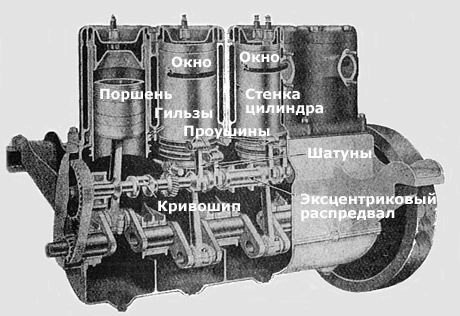
The Knighta engine is different from the traditional DSS with a gas distribution mechanism designed to "remove" the enormous power that is not available for the most common internal combustion engines. History of Knight's engine
History of Knight's engine
At the beginning of the twentieth century, Charles Knight created a four-stroke engine based on a gassy system of gas distribution. Despite the complexity of the manufacture and the relatively high cost, the Knight's motors have gained wide popularity and were often used by various automobile companies.
It is not ruled out that, in the near future, Knight's engine will be the innovator of Toyota, which recently introduced a range of new engines with a record high thermal efficiency
In 1906, the inventor with his partner, Lyman Kilburn, presented to the public the Silent Knight, with a four-cylinder engine. The main advantage of the machine is considerably less noise compared to the analogues of that time. After some time, different variations of Knight's engines began to be developed outside the United States, for example in France, Great Britain and other countries.
The Knighta multi-cylinder engines were produced by Rolls-Royce, "Nipier" and "Bristol". The power of the engine could reach 3.5 thousand h.p. These engines were unparalleloable and were the most powerful. During the Second World War, such units were used in aviation.
Knight's device and operating principle
The engine of the Knight's engine is based on the work of the mobile cartridge cases in the cylinder equipped with a working piston and large side windows. When the cartridge is moved, the window's data is periodically the same as the intake or outlet port located in the cylinder wall. As a result of the cycle, a combustible mixture is arriving in the cylinder and the exhaust gases are removed.
Daimler Motoren Gesellschaft also failed to pass a promising engine. The Mercedes engine of this type was called Knight
In the twentieth century there were options for the performance of the motors, in which the casings revolved around the cylinder, and did not slide along it. This mechanism has been named "McCallum System". The other alternative was engines with cylinders whose windows were located in the block head and not in the side walls. It should be noted that the motors were less frequent than the Knight's engines.
Cars with the Knight's engine
At different times, Knighta's engines were equipped with machines such as Mercedes, PanhardLevassor, Daimler, Peugeot, Willys, etc. The mechanism has been constantly improved, but the general idea has always remained unchanged. In 1905-1919, one of the main car manufacturers with the Knight engine was "Avions Voisin". A bright representative of that generation became a "Voisin C11" convertible. There were four-, six, and sometimes twelve-cylinder, Knighta engines installed in different models.
Advantages and disadvantages of the knight engine
At the time of the creation, the Knight's engines exceeded the standard valve engines. Large windows for launch and release did not hinder the gas exchange process. The Knight's engine had a high power and had a long service life.
The low level of noise from the Knight's engine was in the process of attracting buyers from the US Army. According to them, Chrysler worked on the creation of a military vehicle
Among the main drawbacks is a weak tightness of cylinders, excessive oil consumption, bad bedding of piston rings and internal cartridge cases. Due to these problems, the engine of Knight has lost its relevance, although throughout the twentieth century many companies have tried to improve this mechanism. However, this type of engine has been superseded by superior analogues.
Knight's engines in the modern phase
Knight's motors have lost their popularity in the 1930s, and today they are not represented in the world market. Advanced gas distribution mechanisms have been replaced, which not only solve the problem of excessive noise, but also have many advantages over the Knight system. Nevertheless, some scientists are considering the possibility of unvalve engines in modern production vehicles. Such statements are regularly published in the media and cause numerous disputes among representatives of the scientific and technical industry.









